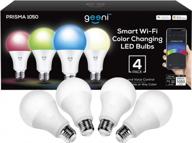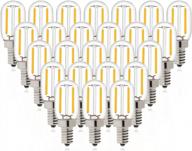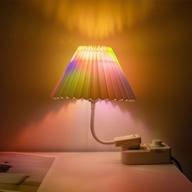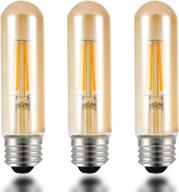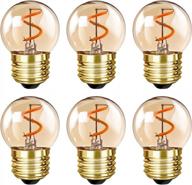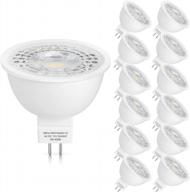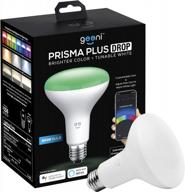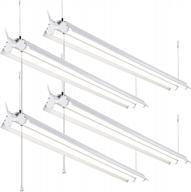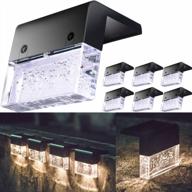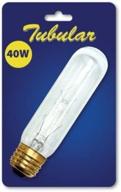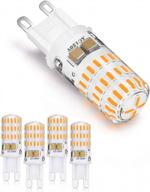Another interesting products
The Past and Present of Incandescent Bulbs
Incandescent light bulbs have been around for over 130 years, and still remain a popular lighting option today. Let's take a look at the history and evolution of this classic light bulb technology.
Top products in 💡 Incandescent Bulbs
The Invention of the Incandescent Bulb
The original incandescent light bulb was invented by Thomas Edison in 1879 after years of experimenting with different filament materials. Edison's bulb consisted of a carbon filament inside a glass bulb, which would glow when electric current passed through it. This was a huge breakthrough in lighting technology at the time.
How Incandescent Bulbs Work
Incandescent bulbs work by heating a tungsten filament wire to a very high temperature using electrical current, until the filament starts glowing. This glowing filament produces visible light. The hotter the filament, the brighter the light emitted.
- Tungsten filament wire inside glass bulb
- Filament heated by electrical current to incandescence
- Glowing filament produces visible light
Improvements in Incandescent Bulb Design
While the basic principle of incandescent bulbs has remained the same, there have been several improvements over the decades:
- Lower wattage bulbs for increased efficiency
- Halogen bulbs with longer lifespan and better light quality
- Use of different gases inside bulbs (xenon, krypton) to optimize performance
- Improved filament designs and shapes for better light distribution
The Rise of Compact Fluorescents and LEDs
In the 1990s, compact fluorescent bulbs (CFLs) emerged as energy saving alternatives to incandescents. And in the 2000s, LED lighting technology took off. While initially expensive, costs for CFLs and LEDs have decreased substantially in recent years. Many consumers have switched away from incandescents due to the energy savings and longer lifespans offered by CFLs and LEDs. However, incandescents still remain popular due to their low cost and familiar lighting quality.
Similar products
The Current Status of Incandescent Bulbs
Despite facing tough competition from more energy efficient lighting options, incandescent bulbs continue to have viability for certain applications:
| Pros | Cons |
|---|---|
|
|
While incandescents are no longer used for general lighting applications, they maintain a niche in the lighting market. Improved halogen and specialty bulbs offer consumers a high-quality incandescent lighting experience, despite the dominance of CFL and LED options. As lighting technology continues to advance, incandescents will likely continue adapting to meet changing consumer needs.
The Pros and Cons of Incandescent Bulbs
Incandescent light bulbs are one of the oldest electric lighting technologies still in use today. Here is an overview of the key pros and cons of incandescent bulbs.
Pros of Incandescent Bulbs
- Inexpensive - Incandescents are one of the cheapest bulb options available.
- Familiar light quality - The warm light is comforting and reminiscent of older eras.
- Good color rendering - The light renders colors well on illuminated objects.
- Fully dimmable - Light levels can be smoothly controlled from 1-100%.
- Instant full brightness - Incandescents reach full brightness immediately upon being switched on.
Cons of Incandescent Bulbs
- Very inefficient - Incandescents waste over 90% of energy as heat rather than visible light.
- Short lifespan - Last only 1,000 hours on average.
- Frequent bulb replacement - High cost and hassle of replacing burned out bulbs.
- Brittle glass bulbs - Prone to breakage and imperfections.
- Burn hazard - Become extremely hot during operation.
Impact on Energy Use
Due to their inefficiency, incandescent bulbs have a much higher energy cost over their lifetime compared to LEDs and CFLs. For example:
| Bulb Type | Wattage | Lifespan (hours) | Energy Use Over Lifespan |
|---|---|---|---|
| Incandescent | 60W | 1,000 | 60 kWh |
| CFL | 13W | 10,000 | 130 kWh |
| LED | 8W | 25,000 | 200 kWh |
Many countries have phased out incandescent bulbs in favor of more efficient lighting. However, incandescents can still be a good choice where the warm light quality and full dimmability are essential.
Choosing the Right Wattage for Your Needs
When selecting incandescent light bulbs, wattage indicates the power consumption and brightness of the bulb. Choosing the right wattage is important for getting sufficient light for a space without using excess energy. Here are some tips for selecting the best wattage bulb for your lighting needs:
Consider the Size of the Fixture and Room
Higher wattage bulbs produce more lumens, which determine brightness. For larger light fixtures and rooms, you generally need higher wattage bulbs like 60W or 75W to produce enough light. Smaller fixtures and rooms only require lower wattage bulbs like 40W or 25W.
Factor in Distance from Light Source
If a light fixture is mounted high up on a wall or ceiling, you need higher wattage to compensate for the increased distance to where light is needed. For fixtures mounted low or close to illuminated areas, lower wattages are sufficient.
Match Bulb Type to Fixture Design
Check the fixture labeling for recommended bulb types and wattages. Using a wattage higher than specified can lead to overheating and fire hazard. Common wattage guidelines include:
- Ceiling fixtures - 60W to 100W
- Vanity fixtures - 40W or 60W
- Table/floor lamps - 40W to 75W
- Wall sconces - 40W or lower
Consider Lighting Needs by Room
Each room in a home or office has different lighting needs. Some typical wattage recommendations:
- Living room - 60W to 75W
- Kitchen - 50W to 65W
- Bedroom - 40W to 60W
- Bathroom - 40W or lower
- Hallways - 40W or lower
Take Bulb Shape into Account
Bulb shape affects light distribution. Narrow spotlights require lower wattage like 35W. Wider omnidirectional bulbs need higher wattage like 60W to spread light around.
Consider Lamp Dimming
For fixtures controlled by a dimmer, LED and CFL bulbs are recommended. Use higher wattage incandescents so the bulb produces sufficient light when dimmed.
Choosing the correct wattage results in optimal light quality and brightness, without excessive energy usage. Reference fixture labels, room sizes, and lighting needs when selecting bulbs. Adjust wattage up or down to achieve the perfect lighting ambiance.
Maximizing Incandescent Bulb Lifespan
Incandescent bulbs have a relatively short lifespan, typically 1,000 hours or less. However, there are ways to maximize incandescent bulb longevity and avoid frequent bulb replacement.
1. Operate Bulbs at Rated Voltage
Operating bulbs at higher than rated voltage greatly shortens filament life due to overheating. Always check bulb and fixture labels for voltage compatibility. Use 120V rated bulbs in 120V circuits.
2. Avoid Vibration Near Bulbs
The tungsten filament in incandescent bulbs is fragile and prone to breakage. Avoid installing bulbs where vibration can occur, such as:
- Ceiling fans
- Pendant fixtures in high-traffic areas
- Lighting on pool equipment or appliances
3. Properly Control Heat Output
Operate bulbs in open fixtures that allow heat to dissipate freely. Confined lighting cans lead to overheating, reducing bulb life. Also avoid covered bulbs touching insulation or flammable materials.
4. Use Bulb Grease in Vibrating Sockets
Vibrating light sockets can cause early filament failure. Coating bulb bases with dielectric grease reduces friction and enhances lifespan.
5. Handle Bulbs Gently to Avoid Shocks
Dropping or jarring bulbs can weaken filaments. Always handle bulbs gently by their bases when installing. Also transport bulbs safely during moves.
6. Clean Bulbs and Fixtures Regularly
Dirt buildup on bulbs and fixtures can trap heat. Clean bulbs and lenses every 3 months with rubbing alcohol for maximum heat dissipation.
7. Turn Off When Not in Use
Don't leave bulbs burning unnecessarily when rooms are empty. Timer switches or occupancy sensors can automatically turn off lights.
8. Use Bulbs in Suitable Temperature Range
Bulbs perform best between -18°C to +40°C (0°F to 104°F). Avoid unheated attics or garages prone to high temperature swings outside this range.
Following these guidelines can help maximize incandescent bulb lifespan 2-3X longer than rated 1,000 hour averages. Take proper care and bulbs will provide years of bright, quality illumination.
Decorative and Specialty Incandescent Options
While general service incandescent bulbs are increasingly being phased out in favor of more energy efficient CFL and LED lighting, there is still a wide array of decorative and specialty incandescent bulbs available for consumers.
Shapes and Sizes
Incandescents come in a variety of shapes beyond the standard A-shape bulb:
- Globe bulbs - Spherical shape provides soft, diffuse light
- Flame tip bulbs - Pointed tip bulbs common in chandeliers
- B, BA, C, CA bulbs - Candle-shaped bulbs used in sconces and fixtures
- G bulbs - Short, compact bulbs fitting small fixtures
Colors
Colored bulbs with tinted glass or coatings create accented lighting:
- Red, blue, green - Produce colored light for effect
- Amber, yellow - Provide a warm, soothing glow
- Blacklight/UV bulbs - Glow purple for special effects
Specialty Bulbs
- Three-way bulbs - With adjustable light levels
- Rough service bulbs - For vibration resistance in appliances
- Shatter resistant bulbs - Bulbs with a plastic safety coating
- Showcase / oven bulbs - For appliances, high temp tolerance
Halogen Incandescents
Halogen bulbs provide brighter, whiter light in a compact shape. Popular options include:
- Floodlights - For accent and spot lighting
- Capsule bulbs - For track lighting
- G4/G9 bases - For decorative fixtures
- R/PAR reflector bulbs - For recessed and track fixtures
Buying Tips
- Match bulb shape, base, and specifications to the intended fixture
- Check wattage ratings to avoid overheating
- Consider dimmable bulbs for adjustable control
- Buy from reputable lighting retailers for safety and performance
With the right specialty bulb, incandescent lighting can produce stunning decorative effects from the subtle to dramatic. Consult manufacturer catalogs for the complete array of options.
The Future of Incandescent Lighting
The incandescent light bulb has been a mainstay of residential and commercial lighting for over 130 years. However, with the rise of more energy efficient lighting technologies like CFLs and LEDs, what does the future hold for incandescent bulbs?
Declining Popularity
Many countries have implemented policies to phase out incandescent bulbs in favor of CFL and LED lighting. These newer technologies offer 80-90% energy savings compared to incandescents. As costs for CFLs and LEDs continue to decrease, adoption will keep rising while incandescent sales decline.
Remaining Niche Applications
While no longer used for general illumination, incandescents will retain niche applications taking advantage of their unique properties:
- Ovens/Appliances - High heat tolerance
- Specialty bulbs - Shapes/colors for decorative fixtures
- Stage lighting - Full dimmability for theaters
Efficiency Improvements
Manufacturers are developing more efficient incandescent technologies to extend their competitiveness:
- Halogen IR bulbs - Up to 30% more efficient
- Xenon/krypton filled bulbs - Reduce filament evaporation
- Better filament materials - Last longer at higher temperatures
Smart Lighting Integration
As smart lighting gains adoption, manufacturers may integrate incandescents into connected systems, allowing features like:
- Remote control via smartphones/voice
- Integration with home automation
- Smart scheduling and automatic shutoff
Cost and Energy Use Improvements Unlikely
Despite potential advancements, incandescents will likely remain more expensive over their lifetime compared to CFLs/LEDs due to fundamental limits on their energy efficiency. The thermal process of producing light cannot effectively compete with solid-state lighting.
While still retaining some specialty roles, old-fashioned incandescent bulbs are slowly fading in favor of more advanced energy-efficient lighting. But their familiar warm glow will always hearken back to the origins of electric illumination.
Are All Light Bulbs LED?
No, not all light bulbs are LED. There are four different types of light bulbs available for residential use: incandescent, halogen, fluorescent, and LED. Incandescent bulbs are the traditional bulbs that have been used for over a century, but they are being phased out in many countries due to their inefficiency. Halogen bulbs are similar to incandescent bulbs but are slightly more effective. Fluorescent bulbs are more energy-efficient than incandescent bulbs but contain small amounts of mercury. LED bulbs are the most energy-efficient and longest-lasting bulbs on the market.
Types Of Energy Efficient Light Bulbs
There are several types of energy-efficient light bulbs available for residential use. Here are the main types:
- LED bulbs: These are the most energy-efficient and longest-lasting bulbs on the market. They use up to 90% less energy than traditional incandescent bulbs and can last up to 25 times longer. They are also available in a variety of colors and can be used in many different types of fixtures.
- CFL bulbs: Compact fluorescent lamps (CFLs) are much more efficient than traditional incandescent bulbs, using up to 75% less energy and lasting up to 10 times longer. They are also available in a variety of colors and can be used in many different types of fixtures.
- Halogen incandescent bulbs: These bulbs are similar to traditional incandescent bulbs but are slightly more efficient. They are also cheaper than other energy-saving bulbs and come in a variety of colors.
- Traditional incandescent bulbs: These bulbs are the least energy-efficient and have a short lifespan. They are being phased out in many countries due to their inefficiency.
Overall, LED bulbs are the most energy-efficient and longest-lasting bulbs on the market, making them the best choice for those looking to save money on their energy bills and reduce their environmental footprint.







